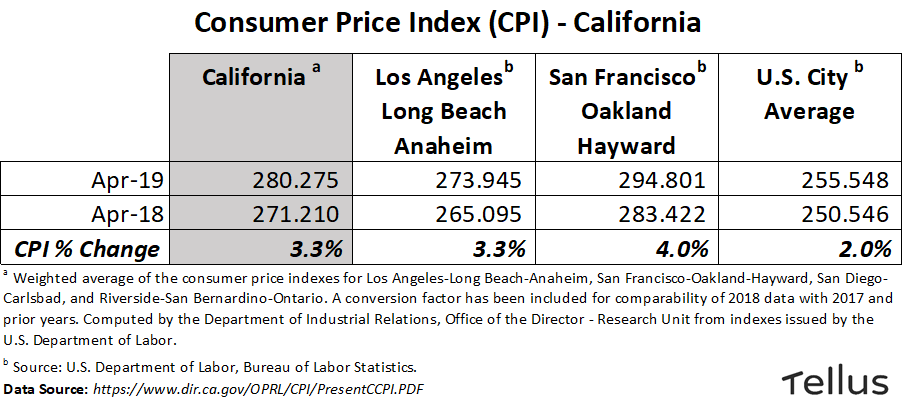
California Passes Statewide Rent Control in 2019
California just passed statewide rent control on September 11, 2019. Read more about what this means for landlords and tenants.
Previously only enforced at a local level, California just passed a bill that extends rent control across the entire state. Assembly Bill 1482 caps rent increases at 5% and changes the law regarding evictions. These changes will be in effect for the next 10 years starting January 1, 2020.
Rent Caps
Previously in California cities without rent control, there was no ceiling on how much landlords could increase the rent.
With the new law, landlords are limited to a 5% increase (plus inflation) each year for the next ten years. For example, if rent is $2000, a landlord would be able to make an increase of $100 (5%) each year. This increase does not include inflation; once inflation is accounted for, the total increase may range from 8%-9%.
Inflation
The U.S. Bureau of Labor Statistics calculates inflation by comparing the price of goods between this year and last year.
California’s new rent control law says landlords must adhere to local inflation rates as published by the U.S. Bureau of Labor Statistics. If statistics are not available for a landlord’s region, then they must adhere to the inflation rate for the state set by the Department of Industrial Relations.
The following table gives inflation rates (CPI % change) for the past year in California:

Eviction Laws
Before this law was enacted, a landlord who wanted to sell their property or make major renovations had the option to terminate a tenant’s lease agreement. This is known as a “no-fault just cause” eviction, since the tenant is being asked to leave through no fault of their own, but the landlord has reasonable justification for asking them to leave.
Under the new law, landlords may still engage in no-fault just cause evictions for tenants who have been living on the property for less than a year. However, once a tenant has lived on the property for a year or more, all evictions must be “just cause” evictions. This means a landlord can only evict their tenant for lease violations, non-payment of rent, and committing a nuisance or waste to the property.
If a landlord still wants a tenant to leave and does not have just cause, they may still evict their tenant provided they offer them relocation assistance in the form of one month’s rent. Landlords could either give their tenants the money directly or waive the last month’s rent.
Who is exempt from California rent control?
While the law is state-wide, it does not apply to every property.
Properties built within the last 15 years are exempt from the new law.
The law does not apply to single family homes, unless they are owned by corporations.
Owner-occupied housing (including duplexes) is also exempt, provided the owner does not rent out more than two rooms or units. This includes Accessory Dwelling Units (ADUs).
The new law does not override existing rent control laws at the local level.
When does California rent control take effect?
California rent control takes effect on January 1, 2020. It will last for 10 years until January 1, 2030.
The law specifies March 15, 2019 as the cut-off date for establishing a rental price. In other words, the rental price of a landlord’s property on March 15 will be the base from which they will be able to make increases in the new year.
If a landlord has increased the rent between March 15, 2019 and January 1, 2020, there are two clauses that will affect them:
- If the rent increase is more than the 5% plus inflation cap, the rental price on January 1, 2020 reverts back to the price on March 15, 2019 plus the maximum permissible increase. Landlords are not liable for tenants’ overpayment.
- If the rent increase was less than the 5% plus inflation cap, landlords will be permitted to raise the rent twice within a 12 month period from March 15, 2019 to March 15, 2020. Under no circumstances should the total amount of these two increases exceed the 5% plus inflation cap.
How does the new California rent control law affect landlords?
Landlords can no longer raise the rent however much they want. Even if their expenses are higher than their rental income, they must still adhere to the law. In this way, many landlords feel that rent control is a direct threat to their business.
Rent control creates a much more long-term relationship between the landlord and tenant; tenants are less likely to move, and it’s harder for a landlord to evict them. Increased eviction regulations gives landlords less freedom in how they want to use their property. Any renovations that would force their tenants to move are no longer acceptable unless the landlord pays relocation assistance.
How does the new California rent control law affect tenants?
Tenants now have greater protection under California law. The 5% increase cap makes future rent prices more affordable. Renters also have more long-term stability, knowing that they cannot be evicted unless they violate their lease.
Previously, when landlords had the flexibility to determine when and how much they would raise the rent, some landlords chose not to make annual rent increases because they could make up for it with a larger increase later. Now that rent increases have a cap, tenants may see more regular increases each year.
Will rent control help alleviate the housing crisis in California?
There are several challenges facing California renters. One is rental price. The other is housing availability.
Economists explain the problem through supply and demand. Since demand for California housing is high and supply is low, the rental price increases. Building more housing would increase the supply, but some economists point to rent control as a limiting factor. They believe rent control discourages new housing construction since developers are less likely to make a profit with increased regulations. For this reason, they claim rent control will exacerbate the housing shortage in California. The new law attempts to address this by exempting housing built within the last 15 years.
In the same way, increasing regulations for landlords does not incentivize them to invest in rent controlled areas, especially if their business will no longer be profitable. A 2019 Stanford study claimed rent control would reduce housing supply by 15% due to landlords taking their properties off the market. In San Francisco, many apartments sit vacant for this exact reason. Estimates for the number of vacant San Francisco apartments range from 10,600 (5%) to 25,000 (11.8%) of the total rental apartments in the city.
Proponents of the bill claim rent control gives some pricing stability in a market where—if market forces were left unchecked—prices would continue to rise faster than wage increases. Tenants will no longer see rent prices double, an occurrence not unheard of in high-priced areas when a property comes under new ownership. Proponents also believe the bill protects tenants against evictions and homelessness by giving them a stronger guarantee for housing.
Ultimately, while the law affects the rental price of existing housing, it does not increase the housing supply in California.
Final Word
Rent control is a hot-button issue, and it’s starting to affect more states. California is the second state to pass state-wide rent control after Oregon. New York recently passed a bill giving tenants greater rights and protection. This new law in California may be part of a larger trend of increasing state-level regulations for landlords.








